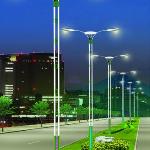
Smart LED Streetlamps system through the implementation of mesh networks by hector_bracamontes
 2013buildingefficiencyjudges 2013buildingefficiencyjudges Jul 8, 2013 09:26 |
Dear hbraca,
Thank you for your submission and congratulations on being selected as a finalist for the final judging round. We thought that your proposal was strong because it was specific and actionable. On that note, however, our advice for the final round would be to add as much as you can in the sections on the cost and timeline, since we would be very interested to see more details on how this plan might become a reality.
|
 2013buildingefficiencyjudges 2013buildingefficiencyjudges Jul 29, 2013 02:05 |
Comments from Judges are listed below:
- A good idea, but it doesn't push the envelope of what is already happening out there. I'd like to see the author(s) put more thought into how else the mesh networks can be used. Rather than framing it in terms of city budget, should also frame in terms of city electricity use. The author should consider what else the mesh network can be used to achieve. For instance, sensors would allow all kinds of information collection from pollution levels to GHG concentrations to weather conditions to extreme weather prediction to warning systems to what else? I think this should be thought through. It makes sense to add the sensors to the project. Also, the author may have underestimated the "man-hours" costs by a large factor. Proposal would benefit from a review by a native english speaker.
- Seems quite doable and has been done (or nearly) at other scales. This is largely a demonstration at smaller scales. Not clear why this is necessary, except that limited finances and risk aversion of smaller cities may well require some working demonstrations as proof of concept.
- Good, simple approach. Would be good to pilot in Mexico and measure actual efficiency gains.
|
 Hank Roberts Aug 3, 2013 10:06 |
If you specify amber "turtle safe" LEDs -- which are much like the amber sodium lamps -- you'll save money on the hardware, save money on the electricity, and avoid the problem from adding more of the wrong color light to nighttime.
www.ama-assn.org/resources/doc/csaph/a12-csaph4-lightpollution-summary.pdf
"Low levels of illuminance in the blue or white fluorescent spectrum disrupt melatonin secretion."
"White" LEDs are like "white" fluorescents -- both of them produce bright blue light inside a coating of fluorescent material that re-radiates the energy. But significant blue gets through.
Also, the white LEDs need higher voltage to run, that costs more (and they are priced higher if you compare)
You have or will have good healthy night lighting anywhere sea turtles nest along the beaches now -- get quotes on those lights, and you'll get the health benefit for people.
Here's one supplier I've known about for a while:
http://www.lsgc.com/fixtures/sea-turtle-friendly-led-fixture/
The same wavelength -- 400 to 500nm, blue-green -- affects people and turtles (and much else).
"... in February, a new Mexican law (known as Official Norm-162) took effect, and it offers a whole slate of new protections for sea turtle nesting grounds in Mexico....
Putting Out Artificial Lights
The regulation also addresses one of the main factors that disrupt nesting turtles: artificial lights from houses, hotels and roads. These light sources can not only disorient nesting females, but they can be lethal to emerging hatchlings. As they climb their way up from their sandy nest, newly-hatched turtles look for the subtle light reflecting off the surf and waves to orient themselves towards the sea. Artificial lighting can point them in the wrong direction ...."
http://www.defendersblog.org/2013/04/mexico-protects-sea-turtle-nesting-habitat/
|
 Christopher Fry Aug 22, 2013 03:03 |
Explore the possibility of streetlamps being completely independent,
ie NO connectivity. They would have solar cells and batteries for power.
They would be switched on and off by themselves via sensors and/or clocks.
With no central maintenance, reliability of the overall system goes up,
costs go down. Its much more modular to extend or reduce in scope.
If this is worse than your existing design, tell us why.
|
 Hector Bracamontes Aug 31, 2013 03:37 | Proposal contributor
Thank you all for your comments and support.
Applications for mesh networks are numerous, we mention some: Electric meter reading, gunshot monitoring, street surveillance, public information broadcast, street parking monitoring, traffic monitoring, traffic signal control, streetlighting control and pollution monitoring. The applications implementation would depend on the actual municipality needs.
Public lighting represents 60% of energy consumption in many municipalities in Mexico and there are around 6 million streetlamps within the country. Thus, public lighting is considered a main concern of municipalities in terms of energy consumption.
Nowadays, the streetlamps are controlled with photocells but a lack of preventive maintenance and staff make them susceptible of failing. Therefore, a telemanagement system is a good option for managing the public lighting and reducing energy consumption from streetlamps, as well as maintenance (e.g. fuel, spare parts).
|